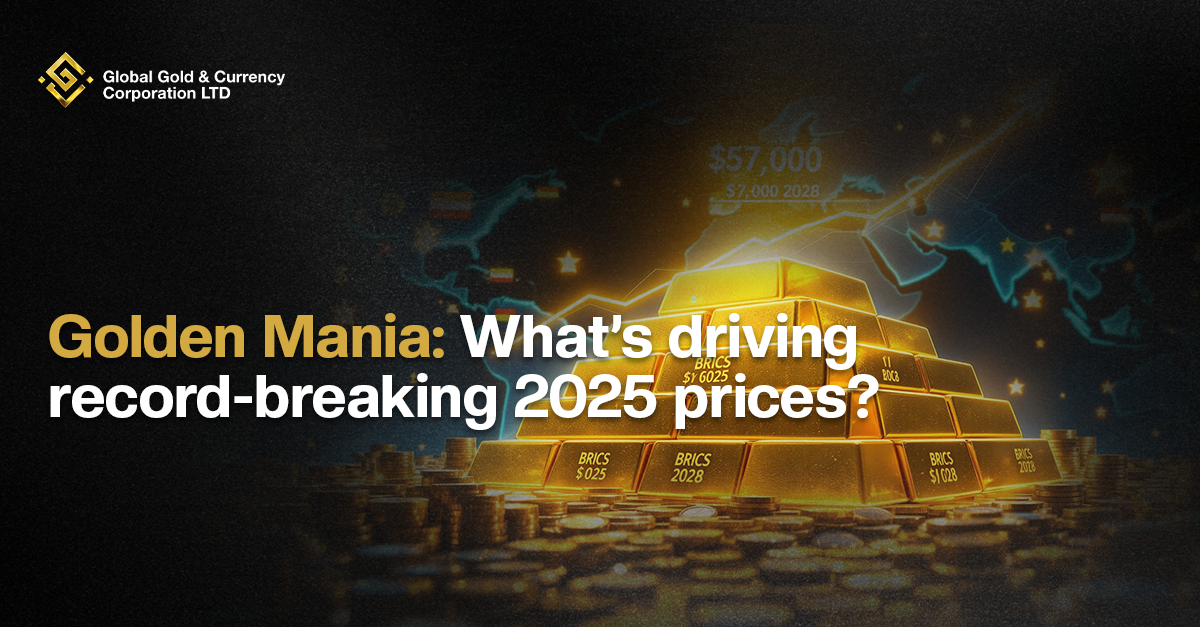
Gold Breaks Records as Global Uncertainty Sparks a Historic Rally
Gold has reached an extraordinary milestone, soaring to an all-time high above $4,000 per ounce in October 2025, marking one of the most remarkable rallies in precious metals history. This unprecedented surge represents not just a numerical record, but a fundamental shift in how investors worldwide are viewing the yellow metal in an increasingly uncertain economic landscape.
The precious metal's meteoric rise reflects a perfect storm of factors: aggressive Federal Reserve monetary policy expectations, escalating geopolitical tensions, persistent inflation concerns, and a global flight to safety that has transformed gold from a traditional store of value into the investment of choice for 2025.
Why Lower Interest Rates Boost Gold Prices
The primary catalyst behind gold's historic ascent is the widespread anticipation of Federal Reserve interest rate cuts. When interest rates decline, gold becomes significantly more attractive to investors for the following several critical reasons:
- Reduced Opportunity Cost: Gold doesn't pay interest or dividends. When interest rates are high, investors can earn attractive returns from bonds and savings accounts, making non-yielding assets like gold less appealing. However, as the Fed cuts rates, the opportunity cost of holding gold diminishes substantially, making it comparatively more attractive.
- Weaker Dollar Dynamics: Federal Reserve rate cuts typically lead to a weaker U.S. dollar. Since gold is priced in dollars, a declining greenback makes gold cheaper for international buyers, spurring increased demand and driving prices higher.
- Inflation Hedge Activation: Rate cuts often signal concerns about economic growth and can contribute to inflationary pressures over time. Gold has historically served as one of the most reliable inflation hedges, preserving purchasing power when fiat currencies lose value.
Current Fed Policy Landscape
Market participants are pricing in multiple rate cuts throughout 2025 and into 2026, as the Federal Reserve navigates a complex economic environment characterized by moderating growth, persistent inflation concerns, and global economic uncertainties. This dovish monetary policy stance has created an exceptionally favorable environment for gold prices.
Investors are positioning themselves ahead of these anticipated cuts, leading to substantial inflows into gold-backed exchange-traded funds (ETFs), increased physical gold purchases, and growing institutional allocation to precious metals.
Safe-Haven Demand: Gold as the Ultimate Crisis Hedge
The current geopolitical landscape is extraordinarily complex, with multiple flash points driving investors toward safe-haven assets:
- Middle East Instability: Ongoing tensions in the Middle East continue to create uncertainty in global energy markets and raise concerns about broader regional conflicts. Historically, Middle Eastern geopolitical risk has been one of the strongest drivers of gold demand.
- U.S.-China Relations: Trade tensions, technology restrictions, and strategic competition between the world's two largest economies are creating persistent uncertainty in global markets, prompting investors to seek the stability that gold provides.
- European Economic Challenges: Economic headwinds in Europe, including energy security concerns and structural economic challenges, are adding to the global uncertainty that benefits gold prices.
- Emerging Market Volatility: Currency instability and political uncertainty in various emerging markets are driving both retail and institutional investors toward gold as a reliable store of value.
Central Bank Accumulation
Central banks worldwide have been net buyers of gold for consecutive years, with many emerging market central banks significantly increasing their gold reserves as part of a strategic diversification away from dollar-dominated assets. This institutional demand provides strong fundamental support for gold prices and signals long-term confidence in the metal's value preservation characteristics.
Chart Analysis and Price Action
Gold's rally to $3,977 represents a breakout through multiple significant resistance levels that technical analysts had identified. The sustained momentum behind this move suggests strong conviction among buyers and indicates that further upside potential may exist.
- Strong momentum indicators showing continued buying pressure
- Increasing trading volumes confirming the legitimacy of the breakout
- Support building at previous resistance levels, suggesting a sustainable advance
- Moving average alignment with shorter-term averages well above longer-term averages, a classic bullish configuration
Historical Context
To appreciate the magnitude of this rally, consider that gold traded around $2,000 per ounce just a couple of years ago. The nearly 100% appreciation in such a relatively short timeframe ranks among the most significant gold bull markets in modern history, comparable to the rallies of the 1970s and the 2008-2011 period.
Portfolio Allocation Strategies
Financial advisors are increasingly recommending higher gold allocations in diversified portfolios. Traditional guidance suggested 5-10% allocation to precious metals, but many are now recommending 10-15% or even higher, depending on individual risk tolerance and investment objectives.
Economic Indicators Supporting Gold's Rally
- Inflation Persistence: Despite central bank efforts to contain inflation, price pressures remain elevated in many economies. Gold's traditional role as an inflation hedge has attracted substantial capital from investors seeking to protect purchasing power.
- Currency Debasement Concerns: Massive government debt levels and ongoing fiscal deficits in major economies have raised concerns about long-term currency stability. Gold offers protection against currency debasement and potential sovereign debt crises.
- Real Interest Rates: Real interest rates (nominal rates minus inflation) remain low or negative in many jurisdictions, creating a favorable environment for non-yielding assets like gold. When real rates are negative, investors effectively lose purchasing power by holding cash or bonds, making gold more attractive.
Expert Perspectives and Market Outlook
Bullish Forecasts: Many prominent market analysts and investment banks have raised their gold price targets, with some forecasting prices could reach $4,000, $4,500, or even higher in the coming months if current trends persist. The reasoning centers on continued Fed easing, ongoing geopolitical uncertainty, and sustained institutional demand.
Potential Risks and Headwinds:
- Sudden Economic Strength: Unexpectedly strong economic data could cause the Fed to reverse course on rate cuts, potentially pressuring gold prices.
- Resolution of Geopolitical Tensions: Significant de-escalation of global conflicts could reduce safe-haven demand.
- Dollar Strength: Any factors causing substantial dollar appreciation could create headwinds for gold prices.
- Profit-Taking: After such a substantial rally, technical corrections are normal and healthy, though they don't necessarily signal the end of the bull market.
Historical Precedents: Lessons from Previous Gold Bulls
The 1970s Gold Rush: During the 1970s, gold surged from $35 to over $800 per ounce, driven by inflation, geopolitical tensions, and currency instability following the end of the Bretton Woods system. Today's environment shares several similarities.
The 2008-2011 Rally: Following the financial crisis, gold rallied from around $800 to nearly $1,900, driven by unprecedented monetary easing, fiscal stimulus, and concerns about the global financial system. Current policies echo many aspects of that era.
The Future of Gold: What's Next?
- Deglobalization trends increasing geopolitical risk
- Currency diversification by central banks and sovereign wealth funds
- Inflation concerns remaining elevated despite central bank efforts
- Demographic shifts in major gold-consuming countries
- Portfolio diversification needs in an increasingly complex market environment
Potential Price Targets: While predicting exact price targets is challenging, the current trajectory and fundamental support suggest gold could potentially move substantially higher if the favorable factors persist. Some analysts see potential for $4,500-$5,000 in a particularly bullish scenario.
Gold's historic rally to $4,000 above per ounce represents far more than just a new numerical record. It reflects a fundamental reassessment of value, risk, and security in an increasingly uncertain world. The convergence of accommodative monetary policy, geopolitical instability, inflation concerns, and safe-haven demand has created an exceptionally favorable environment for the yellow metal.
For investors, gold's role as a portfolio diversifier, inflation hedge, and safe-haven asset has never been more relevant. While trading isn't without risk, gold's 5,000-year history as a store of value and its current fundamental support suggest this bull market may have further to run.
Whether gold continues its ascent to new heights or consolidates recent gains, one thing is clear: the precious metal has reclaimed its position at the center of global trading strategies, offering protection, diversification, and opportunity in turbulent times. As we navigate the remainder of 2025 and beyond, gold will likely remain a critical component of prudent portfolios, continuing to serve its timeless role as the ultimate store of value in an uncertain world.







